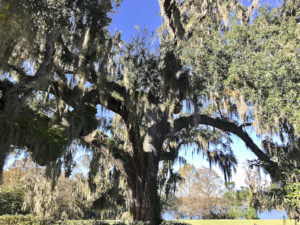
After a wonderful skiing vacation in Bend over the Xmas holidays with Alicia, we jumped at the chance to visit Sooney’s sister in Florida. Yea, 75° daytime temps and blue sky. Just about perfect for viewing wildlife and we took advantage of it. Every day, as a matter of fact. We spotted well over 100 species and have photos to prove it. More importantly, sister Carol was with us 100% each day and we’re planning to bird more with her in Ohio next May.
Flying cross-country is a drag. So, after a 5:30am departure from Medford, we dropped into Miami-Dade at 10pm. Always an ordeal but we keep dreaming of an upgrade to Business Class. The next day we spirited off (jet lag be damned) 5 hours north to Orange County for a family reunion with our niece, Catherine. That was our base for 5 nights at their beautiful home in Winter Park. Most visitors to the greater Orlando area include Di$ney theme parks in their itinerary. Next in popularity is the Kennedy Space Center at Cape Canaveral. We chose to visit neither (with the exception of a brief visit to Canaveral Beach to view the Atlantic Ocean), and opted for the magic of the natural world: the Harry P. Leu Gardens, the Kraft Azalea Garden, the Lake Apopka Wildlife Drive, the Orlando Wetlands (in Christmas, FL), and Merritt Island National Wildlife Refuge just east of Titusville.
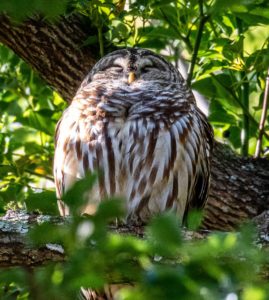
After celebrating Jim’s 75th birthday at the The Ravenous Pig, we spent the following day wandering the expansive Harry P. Leu Gardens. Not far into our walk, we heard the call of a Barred Owl. It was really close, and hunkering down somewhere in the hundreds of ancient Southern Live Oaks populating the garden. Our necks were strained as we scoured the canopy to no avail.
“Is that what you’re looking for?” asked Catherine, who was accompanying Jim a short distance behind us, both of them wondering what’s the big deal about. She navigated us to a lower branch where the owl sat, apparently bored with all the human traffic 20’ beneath its perch. Carol, Sooney and I went nuts with excitement, and I hung out with the bird for 15-minutes hoping it would turn into the sun—or at least open an eye. On a positive note, Catherine may, just may, spend more time in Orlando. It’s not only challenging living in Boston, but because the birding is simply too good to pass up in Florida. And they have a beautiful home in Winter Park.
The next day, Jim rode Amtrak back to Coral Gables and we began some serious birding and headed east to the Orlando Wetlands Park. This large wetlands treatment facility uses aquatic plants to polish already treated wastewater before discharging it into the St. Johns River. We slowly walked over 2 miles of trails throughout the facility and thoroughly enjoyed the fertile habitat supporting all kinds of wildlife! Later that afternoon, we found a pond that seemed to be the restaurant of choice for a wide variety of birds. As the sun set behind us, Sooney used her iPhone to captured the wild cacophony of egrets, spoonbills, herons, ibises, storks, coots, (and probably a ‘gator or two) capitalizing on the final daylight hour for a snack before settling down.

Click here for some snapshots gathered during several days of birding.
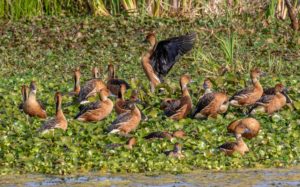
Another birding hotspot is Lake Apopka, also in Orange County. About 20 miles from Orlando, the lake has gone through several transitions. For years, farmers and others sent nutrient-rich water into the lake, polluting what was once a world-class bass fishing destination. The St. Johns River Water Management District bought this land and chose plant species particularly suited to remove nutrients like nitrogen and phosphorus from the water. Firelag, Arrowhead, Pickerelweed, and Arrow Arum have been employed in restoration throughout Florida in projects that benefit birds and wildlife as well as the local economy. In 2015, the District opened the popular Lake Apopka Wildlife Drive. This 11-mile one-way journey allows viewing and photography both from the car or at pullouts along the route. It’s only open Friday-Sunday so we saw plenty of traffic but that didn’t interfere with us spotting another life bird: the Fulvous Whistling Duck.
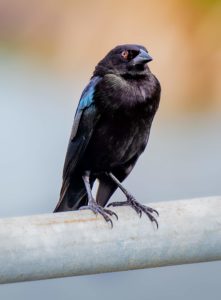
Although the greater Orlando area is terrific birding territory, we headed back to Carol’s home in Coral Gables to reconnect with Jim and search for other treasures. We learned that by checking into eBird.org regularly, other birders’ hotspots became our destinations. At Newton Park, in Winter Garden, FL, we saw another life bird: the Bronzed Cowbird with its resplendent red eyes. The next day we hiked the massive Matheson Hammock Park and Sooney and Carol saw the Scaly-breasted Munia – a rare exotic species and great find. We did occasionally slow down (at one point Sooney actually admitted to being “birded out”). One evening after dinner and a movie, we heard the call of an owl not far from Carol’s driveway. We imitated its call and instantly a tiny Eastern Screech Owl flew to the power lines 10′ above us. That was another life bird for all of us. A photo would have been nice but the memory of that sweet bird chatting with us was as good as it gets.
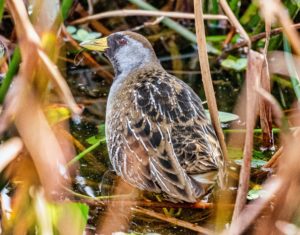
There is much wildlife to be viewed in Florida, and many parks and preserves set aside to enjoy it. An hour north of Miami is the Wakodahatchee Wetlands, in Delray Beach, that is also the home of several posh retirement facilities. The Wetlands are actually a series of water treatment ponds with nearly a mile of boardwalk meandering throughout the park. While some of us birded, quite a few residents from the nearby retirement centers plied the boardwalk as part of their exercise regimen. The paths are wide, and while some trucked by with silly-looking earbuds poking out beneath garish ball caps, others joined us and marveled at our excitement spotting a Sora Rail. This isn’t a particularly rare bird, but it’s elusive and lurks at water level in the shadowy recesses of pond foliage.
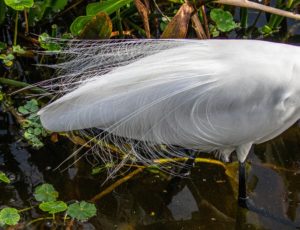
Prior to our temporary departure from a predictable Oregon winter, I revisited my gallery of photos taken on an earlier visit to Coral Gables. Notably consistent are images of the beautiful breeding plumage of the wading birds both then and during this visit. Storks, herons, egrets, and spoonbills were captured in the back-lit late-afternoon sunlight during one of our final days. Marine breezes fluffed the gorgeous feathers that a century ago would have been their death warrant—the popularity of those feathers in the millinery trade nearly wiped them out. As these magnificent birds settled into their roosts for the night, we departed with that wonderful memory intact. The protection allowed Florida wildlife is in jeopardy but during our brief visit we were grateful for what we saw. How wildlife survives hurricanes continues to be a mystery.
